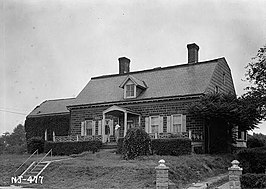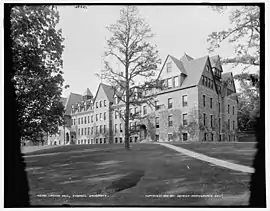Katherine Van Winkle Palmer
Born on February 5th, 1895 , Palmer was a Tertiary paleontologist, a scientist who studies fossils from the Cenozoic Era, and was a geologist.[1] Palmer is recognized for her field/doctoral study on veneracean lamellibranches,[1] a class of bivalve mollusks that include clams, scallops and oysters. Palmer was a director of the Paleontological Research Institution (PRI) in New York.[2] During Palmer's time as the director of the PRI, she oversaw the publication of numerous Bulletins of American Paleontology as well as several issues of Palaeontographica Americana.[2]
Katherine Van Winkle Palmer | |
|---|---|
 | |
| Born | February 5th, 1895 Oakville, Washington |
| Died | September 12th, 1982 |
| Education | Cornell University |
| Alma mater | |
| Spouse(s) | Ephraim Laurence Palmer |
| Scientific career | |
| Fields | Paleontology |
Katherine Van Winkle Palmer
Early life
Katherine Evangeline Hilton Van Winkle Palmer was an only child born to Jacob Van Winkle, a doctor and Mary Edith Hilton Van Winkle, a nurse. [3] Palmer Grew up in the small town of Oakville, Washington,[4] and shared a close relationship with her father, as he was an important figure in her life and introduced her to nature and the outdoors.[3] The two of them would go outdoors and collect fossil mollusks.[3] It was during these adventures that Palmer found her love for science and a passion for fossils.[3] In childhood, she attended various local schools, and became the only girl in her class to eventually go to college. [3]

Education
Katherine attended the University of Washington to study paleontology under the mentorship of Professor Charles E. Weaver (1880-1958). [3] Palmer completed her fieldwork during 1916-1917 for her senior thesis on Age Determinants within Faunal Provinces. [3] She wrote her thesis on the Oligocene fossils found in the Chehalis Valley in Washington.[2] In 1918, Palmer graduated with her Bachelor of Science degree from the University of Washington,[1] and published her senior thesis during that same year.[3] She was a member of the Alpha Delta Pi chapter.[5] For a short period, Katherine was working as a post-graduate lab assistant under Dr. Charles E. Weaver, who focused his study on Tertiary fauna.[4] With Dr. Weaver’s recommendation, Palmer applied for and received a Goldwyn Smith Fellowship (1918-1920) to accomplish graduate work at Cornell University under the east coast Paleogene expert, Gilbert D. Harris (1864-1952).[3] Following this, during (1921-1925) Palmer received an assistantship in Paleontology and Historical Geology to continue her work with Professor Harris[3] helping him create the Paleontological Research Institution.[2] Katherine wanted to become a student of Professor Harris's because at the time, not only was he the Paleogene expert on the East Coast, but the only professor in the Geology department who accepted women as students.[3] Palmer printed out her thesis by typesetting and making the ink plates herself on Harris's own printing press.[3]

Life after Graduation
After Graduation, Palmer continued her education at Cornell University where she received her Ph.D in 1925. As graduation arrived, Katherine received a Hecksher Fellowship in the years (1925-1927) to proceed with her work with professor Harris on Paleogene fossils.[3] Several years later, Harris created the cornerstone for Paleontological Research Institution (PRI) in 1932, and Palmer was alongside him. [3] Palmer actively worked with in the PRI and served with the Board of Directors. [3]During her time with PRI, Palmer accompanied Harris on expeditions and continued to publish her work. Her work was able to be published thanks to her association with PRI. [6] Palmer left the legacy of her student days at Cornell University in the Sigma Delta Epsilon organization, which she founded in 1921 .[3] at the time, this was the only national organization for women in science and later Palmer would become the national president. [3]
Family
While Palmer was still an undergraduate student at Cornell University, she fell in love with Ephraim L. Palmer (1888-1970), who was a Professor of Rural Education and Nature Study.[3] Katherine and Ephraim got married in 1921. [3] The Palmers had two children: Laurence Van Winkle Palmer, born in 1923, and Richard Robin Palmer, born in 1930. [3] The eldest son, Laurence, died at 17 years of age after complications resulting from a streptococcus infection he contracted when he was 4 years old.[3] Palmer and her family often hosted various visiting scholars of Geology and Rural Education, from around the world. They were famous for their gracious hospitality. [3] Palmer's husband, Ephraim Laurence Palmer died on December 18th, 1970.
Career
In 1935, Palmer was appointed Fellow of the Geological Society of America. Palmer was also president of the Malacological Society, an organization dedicated to the research and preservation of mollusks.[7]The same year that Palmer died (1982), she published the first history of the PRI,[4] securing her own, as well as the PRI's, legacy in print. Palmer's research produced more than 150 publications, including Gastropoda of the Claibornian Mid-Eocene of the Southern United States (1937), The Mollusca of the Jackson Eocene of the Mississippi Embayment (Sabine River to Alabama River) (1946), and Catalogue of the Paleocene, and Eocene Mollusca of the Southern and Eastern United States (1965), to name a few.[2] As well as conducting field studies in the United States, Palmer conducted research in the Gulf of Mexico, New Zealand, and the West Indies.[1] Palmer took on many paleontological projects such as fossil catalogues which few other paleontologists covered, but were vital to the field of paleontology.[3]
Contributions in the PRI
Palmer and Harris established the Paleontological Research Institution (PRI) together in 1932, and in 1952 she replaced Harris as director, when he became ill. a post she occupied until 1978.[2] Palmer worked as the Director of Paleontological Research Institution (PRI) until 1978. [4] While at this position, Palmer oversaw the publication of 150 Bulletins of American Paleontology (BAP), which Harris founded in 1895, as well as 20 issues Palaeontographica Americana [2]of founded in 1916.[3] Palmer was also the trustee of both of these publications. Throughout the first 21 years as director, Palmer edited 137 numbers (28 volumes) of BAP and 20 numbers (4 volumes) of Palaeontographica Americana.[4] Palmer also oversaw the publication of 150 Bulletins of American Paleontology (BAP) issues as well as 20 issues of Palaeontographica Americana.[4] The same year that Palmer died (1982), she published her last piece of work as an article about the first history of the PRI,[4] securing her own, as well as the PRI's legacy in print.
Later in Life
Due to Gilbert Harris’s (an American geologist and paleontologist ) illness, and before his death on 4 December 1952, the board appointed Katherine director of PRI in April 1952.She was the logical successor as she had been associated with the institution right from the laying of the cornerstone some 20 years earlier. She also managed to continue her research on Paleontology and take care of her family.[3] Palmer continued her work as the Director of PRI until 1978, even though her health started to significantly deteriorate during the 1970s. [3] Palmer received the Paleontological Society Medal in 1972 as well as the Western Society of Malacologists Award in 1974 in honour of her lifelong contribution to geology.[1] A trailblazer in the field of Geology, to be specific, Paleontology, Palmer died on 12th September, 1982.
Awards and honors[8]
- National Honorary Member of Sigma Delta Epsilon/Graduate Women in Science (SDE/GWIS) (1971)
- Fellow of the Geological Society of America (1935)
- Honorary Member of the Society of Economic Paleontologists and Mineralogists (1966)
- First female recipient of the Paleontological Society Medal in 1972 for her work on Tertiary Mollusca: widely acknowledged as paleontology’s highest professional honor in the United States (1972)
- Western Society of Malacologists Award (1974)
- The Alpha Chapter of SDE/GWIS named their first Award for Excellence after Palmer (1978)
- The Katherine Palmer Award for amateur contributions to paleontology is presented each year by the Paleontological Research Institution (1993)
- "Paleontology is Alive and Well: A Symposium in Honor of Dr. Katherine Van Winkle Palmer" was held at Tulane University in 1978, which included an Honorary Doctor of Science presentation from the University (1978)
- Honorary Life Member of the American Malacological Union
References
- Caster, Kenneth E. (1983). "Memorial to Katherine Van Winkle Palmer". Journal of Paleontology. 57 (5): 1141–1144. JSTOR 1304780. (reprinted in Geological Society Memorials 17:1-4. 1986
- Armentrout, John M., ed. (1981). Pacific Northwest Cenozoic Biostratigraphy. Special Paper. 184. Geological Society of America. p. iv. ISBN 978-0-8137-2184-2.
- "The Lady and Her Fossils: Katherine Van Winkle Palmer (1895-1982)" (PDF).
- "Abstract: Katherine Van Winkle Palmer (1895-1982): The Lady and Her Fossils (GSA Annual Meeting in Denver, Colorado, USA - 2016)". gsa.confex.com. Retrieved 2016-11-18.
- The Adelphean of Alpha Delta Pi, April 1921, vol. 13(2), p. 135.
- "About American Malacological Society". www.malacological.org. Retrieved 2016-11-24.
- Cannon, Max. "The Gertrud Wolfner PRI Archives - Katherine V. W. Palmer, 1895–2002". archives.priweb.org. Retrieved 2016-11-26.